|

by Wes Penre
April 16, 2011
from WesPenre Website
Spanish version
1. In the Aftermath -
Building a New Earth
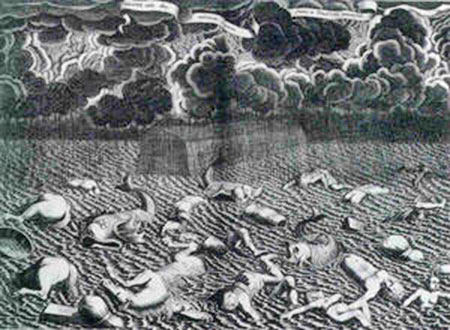
Figure 1
After The Deluge
When the storms had subsided and the rains stopped, Ea and Nammur
saw Ziasudra's fire on top of Mt. Ararat, and landed in helicopters,
while Ninagal set sails towards the mountain.
The Enlil was furious again (was he ever in a good mood?) when he
saw that humans had survived. They were all supposed to have
perished! He was so furious that he wanted to get into a fist fight
with Ea, who calmed him down and said they were not human anymore -
they were his own offspring.
Ninmah and Ninurta, also entering the scene, together
with Ea, convinced Nammur that these few survivals would be the
genesis of a new race on Earth.
NOTE: Each of these human bodies who
died and were killed due to intentional neglect at best and overt
genocide at worst on the gods part, was a soul-carrier. Obviously,
there were a whole lot of these ET individuals who had no respect
whatsoever for intelligent life. Ea and a few others seem to have
been more compassionate, but perhaps that's just on paper?
Not only had Earth been totally devastated after the Deluge; so had
Mars.
The thin atmosphere that once had surrounded the
planet was gone, its waters had evaporated, and now it was just a
deserted planet of dust storms. Nannar reported that from now on,
one could only visit the Moon wearing "eagle masks" (helmets).
So in a sense, Earth had been lucky; the atmosphere
was still there, and the water would soon withdraw and give birth to
new land and slightly different-looking continents.
After had inspected what was left of the "old Earth", the gods found
that some important things they'd once brought down from Nibiru,
like grapefruit trees, had survived, so they could still make wine.
Ea started experimenting with genetics and strengthened the grain
that Ka-in once developed and made bread.
From the seeds Ziusudra/Utnapischtim/Noah had saved
on the ark, the geneticists again began to seed Earth with different
plants, animals and berries. Soon enough (from their "long thoughts"
perspective), life started spreading around the planet again.
Cows and sheep came to life, and Dumuzi, Ea's son,
together with Ziasudra's middle son, became the first shepherds for
the cattle and the sheep.
Ea and Ninagal built dams to tame the Nile in Egypt
and created a pastureland for Dumuzi's herds.
2. Gold, Gold! We Need More
Gold!
Nammur selected the Saudi Arabian peninsula for a new interplanetary
rocket terminal to transport more gold to Nibiru.
This was again a necessity, to the gods' dismay,
because the latest passage of Nibiru had once again ripped off the
gold shield of its atmosphere. All the hundreds of thousands of
years of efforts from the gods and human slaves had been in vain,
and the production had to start all over again, just when they
thought they were at the end of the process.
But the African mines were gone; the slave workers had drowned; the
Anunnaki (most of them) had gone home to Nibiru, and the rocket
terminal in Sippar, Mesopotamia, was destroyed as well.
Ninurta finally came up with some good news. On one of his
expeditions around the planet, he had found an abundance of gold in
Peru, South America, high up in the Andes.
From modern La Paz and east of Lake Poopo, in the
sand from the running into to east coast of Lake Titicaca, he found
lots of it. He also was able to combine copper and tin and create
bronze (remnants of these ancient mining activities can still be
found, both by Lake Titicaca and La Paz).
The bronze was very appreciated, especially when rebuilding
Mesopotamia.
After the Deluge, all they had was brick, but the
bronze could really stabilize the building blocks. It took 7,000
years to rebuild Mesopotamia after the Flood with the limited
equipment left for the gods to work with.
3. The Great Pyramid of
Egypt and the Builders of the Sphinx
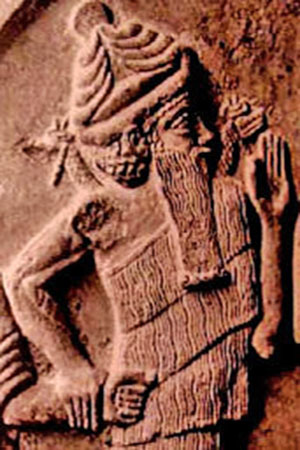
Figure 2
Ningishzidda
Ningishzidda, Ea's son, built two pyramids in Egypt.
The first was a "model pyramid", and the second was
the Great Pyramid.
He built the Great Pyramid at the South End of a
straight line through the landing platform in Lebanon (Baalbek) to
Mt. Ararat (Eastern Turkey) in the North. Then he installed the
Nibiran master computer programs and astronavigation equipment in
the Great Pyramid.
Ningishzidda had done an excellent job with the Pyramids and to
create the technological base, and Ea wanted to reward his son for
work well done. So he decided that a monument should be build in his
son's image. So he let build the Sphinx, which had the body of a
lion, but with Ningishzidda's head sculptured out.
Let us beside the twin peaks a monument create, the Age of the Lion
to announce. The image of Ningishzidda, the peaks' designer, let its
face be. Let it precisely toward the Place of Celestial Chariots
gaze.[1]
Nammur ordered his son, Utu (Apollo in Rome, and Helios in Egypt),
to be in charge of the Sinai Spaceport on the 30th
Parallel, which now separated the Enlil's domains from that of the
Enki's.
The latter was in charge of the realms south of the
30th parallel.
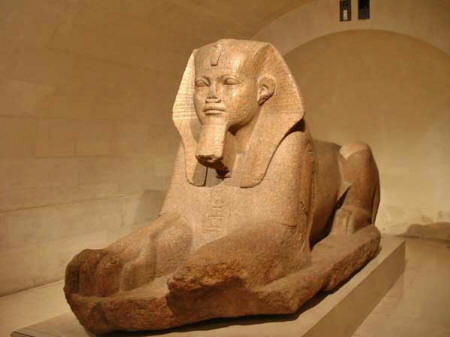
Figure 3
A model of The Sphinx with its
original beard intact
and with the cobra-like
head-dress,
symbolizing the Serpent Clan (The
Clan of Knowledge) - the Enkiites.
In Section 9 below we will read
how Marduk replaced the original head of the Sphinx
with that of his son, Asar, in an
attempt to rewrite history.
(The Louvre)
In the Great Pyramid, Ea's son, Gibil installed pulsating crystals
and a capstone of electrum, to reflect a beam of incoming
spacecraft.
Mission Control perched on Mount Moriah (future
Jerusalem), out of reach for humans.
4. Marduk Becomes Ra and
Amen Ra
Marduk, who inhibited a great ego and lust for power, was jealous of
Ningishzidda for have been rewarded with the building of the Sphinx
in his image. He went to his father, Ea, and complained.
He said that Ea once promised him power and glory,
and look; he got none!
Marduk's mind darkened from resentment.
The tension between the Enlilites (called the RAM Clan) and the
Enkiites (the SERPENT Clan) [2] grew bigger and bigger, but Ninmah,
the great peace-maker, decided they should divide the lands further
into kingdoms, with local rulers. The suggestion had a positive
response amongst the clans.
All the royal clansmen on both sides were dedicated certain areas,
and Marduk was by Ea appointed to be the ruler of Egypt (we are
going to concentrate a little bit extra on Marduk, because he will
be an important figure from hereon, all the way up to present time).
Thus Marduk felt like his father had at least made an effort to
satisfy his imperatives to become a ruler.
So, about 9,800 years ago, Marduk was assigned Egypt
and became Ra. He was now in charge of the workers there.
Ninurta built a palace for Ninmah on Mt. Moriah, and Nammur and Ea
awarded her the title Ninharsag (Mistress of the Mountainhead).
According to Sitchin, she is also equivalent to Hathor in Egypt.[3]
Enki moved to Elephantine (Abu) Island near Aswan (Syene). From
there, he supervised workers building dams, dykes, and tunnels to
prevent the Nile from flooding and control its pathway to the
Mediterranean.
Ea was known as Ptah in Egypt.
5. The Murder of Osiris and
the Battle Between Horus and Seth
To bring the story forward, let's contradict that by going back in
time for a short moment, to that of the Deluge, 13,000 years ago.
At that time, Marduk, together with his hybrid wife,
Sarpanit, and their sons, Asar (Osiris) and Satu (Seth/Set) took
shelter on Marsbase with the Igigi commander, Shamgaz.
Asar and Satu
(from hereon I will call them Osiris and Seth for simplicity)
married Shamgaz' daughters, Asta (Isis) and Nebat (Nephys). Shamgaz
and Seth became pretty close.
Osiris and Isis resided close to Marduk Ra in the northern lowlands
of the Lower Egypt. Seth and Nebat settled in the mountains of
southern Upper Egypt, near the villa of Shamgaz and the Landing
Platform in Lebanon.
Shamgaz decided to set Osiris up, because he favored Seth and Nebat
before Osiris and Isis. He told Seth that Osiris would always be
Marduk's favorite, and even more so because he lived closer to his
father. So, Shamgaz, Seth and Nebat decided to assassinate Osiris.
Hence, Shamgaz and Seth invited Osiris to a banquet and poisoned his
wine.
Osiris fell unconscious, and they put him in a coffin
and threw the coffin into the sea.

Figure 4
Horus and Seth
Marduk Ra, his wife Sarpanit, and Isis, got the news about Osiris'
murder, and hurried to retrieve the coffin.
They found it floating in the sea and brought it
ashore. Legend says that Osiris' corpse was cut into pieces and
spread out, and only parts of his body was floating in the coffin.
The myth further tells us that Isis searched all over
Egypt for the remains of her husband and found all the pieces,
except for his penis, although, as we know, cutting off each other's
genitals was nothing new amongst the gods.
What is true or not in
that story is hard to say, but Sitchin mentions nothing, to my
knowledge, about the lost penis story.
According to him, Osiris' body was intact, and Enki
and Isis took semen from Osiris' corpse and impregnated Isis with
it, unbeknownst to Seth and Shamgaz.
What is true, though, and a theme through Sitchin's
books (especially in "The
Wars of Gods and Men") is that the gods, when they fought
each other, rather than just killing their opponent, they castrated
him and threw the penis away.
This barbaric treatment of an enemy sounds pretty
horrific, but it was implemented by the gods so that the defeated
god could not reproduce and continue his bloodline. In other words,
it was a reassurance of power and dominance.
Seth, proud of his accomplishment of killing his brother, now
declared himself, as the only remaining son of Marduk Ra, to be the
ruler of both Upper and Lower Egypt.
Isis, however, declared she was pregnant by Osiris,
went into hiding and gave birth to Horon (Horus). She trained him
well to become a great warrior to be able to defeat Seth, who
gathered an army of humans and advanced by force towards Lebanon,
all to the border of Ninharsag's neutral Jerusalem region.
When Horus grew up, he was trained and ready to meet Seth in battle.
He gathered his own army and started marching. Seth noticed that
Horus was pretty well prepared, and to stand any chance to win the
conflict, he challenged Horus to a combat man-to-man.
A far ranging air battle took place. Horus hit Seth with a blinding
weapon and then with some kind of harpoon. Blind, Seth crashed, and
his testicles were squashed (or more likely, cut off by Horus?).
Horus bound Seth and dragged him before the Council.
The verdict was to let Seth live the rest of his life
on Earth together with the Igigi astronaut corps, but without
life-extending treatments.
6. Inanna's (Ishtar's) War
Against the Serpent Clan
Nammur and his Ram Clan were afraid that Ea and his Serpent Clan
would control Earth space facilities.
The Serpents controlled everything regarding shipping
of gold, and Marduk even was in charge of space travels between
Earth and Nibiru. Hypothetically, the Serpents could stop the Rams
from even leaving the Earth.
In secret, Nammur therefore sent Ninurta to set up the base in
today's Peru, next to the Titicaca Lake, run by Enlil's son, Ninurta.
She also built a spaceport on the plains next to the Andes.
This area, being rich in gold, was now in the
stronghold of the Ram Clan, and in the middle of this rivalry, two
Anunnaki from opposite clans fell in love.
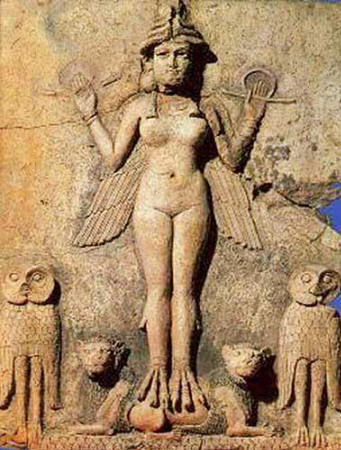
Figure 5
Inanna
Inanna is known under many
different names, such as:
-
Aphrodite
-
Venus
-
Ishtar
-
Athena
-
Kali
-
Ninni
She was also a son's daughter of Lord Nammur, the
Enlil. Her parents were Nannar and Ningal.
Dumuzi, as we know, was Marduk's brother and Ea's son. Dumuzi was
born on Earth, and so was Inanna. Therefore, they were short-lived
in comparison to those who were born and stayed on Nibiru.
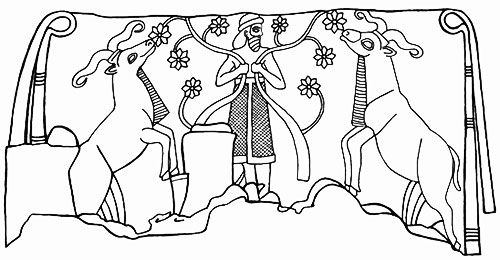
Figure 6
Dumuzi
Around 8,670 BC, the two started laying eyes on each other and
became lovers.
Inanna revealed to Marduk's sister what her plans
were: she wanted to build a great nation on Earth and be the ruling
queen thereof, while her spouse would be given status in the empire.
When Marduk's sister came back and told him about this, Marduk did
not like what he heard. He wanted no competition from his brother.
He and his sister, Geshtinanna, therefore decided to set Dumuzi up.
She seduced him and let Dumuzi have intercourse with her. After the
fact she scared him and told him that Marduk would accuse him of
rape and he would be in deep trouble. Dumuzi was terrified and fled.
However, he was in such a hurry that he accidentally slipped on a
stone, fell into a waterfall and drowned.
That was the end to peace between the two clans.
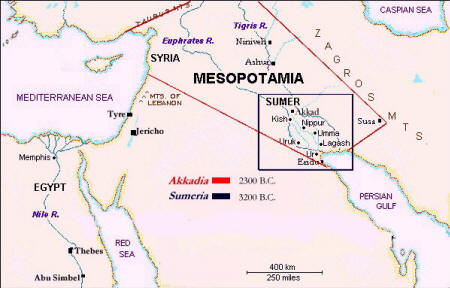
Figure 7
Map of Mesopotamia and Akkadia
Inanna was furious and wanted to take revenge for Dumuzi's death, so
she went to war against Marduk.
Ea and his clansmen supported Marduk in the feud, and
Marduk's grandson, Horon/Horus joined him as well, together with the
Igigi astronauts, and in one of the battles Inanna managed to blind
Horus' right eye.
Inanna showed to be a very skilled warrior and strategic, and she
moved in closer and closer on Marduk, who fled and took shelter in
the Great Pyramid of Giza.
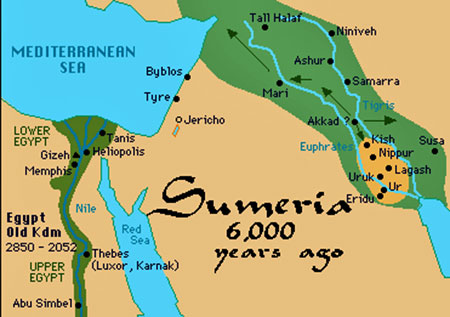
Figure 8
Sumeria, 6,000 years ago
On foot, Inanna, Iškur/Adad (Nammur's youngest son) and Ninurta
cornered Marduk in the pyramid, in one of the air-tight chambers.
Instead of killing him in an instance, they decided to bury him
alive, so they put stones before the entrance to the chamber and
left Marduk to his destiny.
The Serpent Clan brought up the issue before the Council and asked
them to spare Marduk's life, but Inanna insisted that he deserved it
after what he'd done to his own brother.
Ninhursag brought the two feuding brothers, the Enlil and the Enki
before the Council and suggested they exile Marduk and put Ninurta,
Nammur's son, in his place and thus create a clan shift. This became
the final verdict.
Ningishzidda unsealed the chamber and found Marduk unconscious
inside. Nammur's eldest son managed to revive him and helped him out
of the chamber. He was put before the Council and got the verdict
first hand.
So Marduk, his wife Sarpanit, and his son Nabu were
exiled,
"to a place where horned beasts were hunted, a
land uninhabited by the descendents of Ziusudra/Noah."
[3]
7. King Anu Decides to Give
Earth to Humankind
A new dispute took place when Nammur appointed his son, Ningishzidda
(known as Thoth in Egypt), as the Lord of the Nile lands.
Inanna, who'd fought the war against Marduk and won,
demanded she'd get her own part of the Kingdom.
They could not come up with a working solution that all parties were
satisfied with, so they called on King Anu of Nibiru to resolve the
conflict. Anu hadn't visited Earth for 7,000 years, and he had great
affection for Inanna, so he decided to heed the call for help.
At this time, 7,200 years had passed since the Deluge, Humans had
proliferated from the mountain lands to the lowlands. They
originated from Ziusudra, but had Anunnaki genes. Offspring of the
Igigi Mars astronauts were also around. In the distant lands Ka-in's
people had survived.
Anu and his wife, Antu, landed at
Tilmun (Land of the Missiles)
on the Sinai.
Anu was shocked when he saw how much Nammur and
Ea had aged; they looked old and bearded, and Ninhursag, once a
stunning beauty, was now old and bent. Anu, who was much older,
looked younger than the children.
Ea told his father about the message he got from Galzu about how
they had to stay on Earth and couldn't go back to Nibiru, or they'll
die.
Anu said he never sent such a message at all and had
no idea what they were talking about. He thought their staying on
Earth was their own, determined decision (apparently there was a
great lack in communication here).
Ea continued and said that because of Galzu's message, the seed of
mankind was saved from the Deluge, and would otherwise have been
destroyed forever and humankind would have been extinct.
Anu sat back in wonder. Then he said that it appeared that Galzu
came as a messenger for the One God, in an effort to save
mankind[5]. Anu continued, saying that it seemed like they, the
Nibiruans, were only emissaries for the human species, and humankind
is destined to inherit the Earth and make it their own.
Anu now believed it was his and his people's job to
educate them and give them knowledge so they can advance. Then, when
they were educated enough, the Anunnaki should leave the planet!
So King Anu dedicated four major regions to three different groups:
-
Region 1:
Enlil's lineage's domain: Enlil and his
lineage, decreed the King, rule Mesopotamia through their
designated kings, descendants of Ziasudra's sons, Shem and
Japhet the Fair. Ziasudra's eldest son, Shem (Šem), and his
descendents, rule the nations from the highlands running
from the Persian Gulf to the Mediterranean.
Around 3800 B.C., Shem's descendents settle
the ex-spaceport area of Iraq and the Landing Place at
Lebanon.
Shem's brother Japhet rules for the Enlilites
from the highlands of Asia Minor, the Black and Caspian
Seas, as well as the nearby coasts and islands, as they
recover from the flood.
-
Region 2:
Enki's lineage's domain: King Anu orders Enki
and his descendents to rule Egypt and Africa though the
descendants of Ziasudra's son Ham the Dark.
Ham's line rules Caanan, Cush, Mizraďm, Cush,
Nubia, Ethiopia, Egypt, and Libya, beginning from the
highlands and spreading to the reclaimed lowlands.
-
Region 3:
Inanna's domain: Inanna, said Anu, would rule
the Indus Valley (to be settled around 2800 B.C.) as a
grain-source for the other regions.
-
Region 4:
Ninharsag's domain: The forth region, Tilmun
(Sinai), Anu declared, shall be ruled directly by Ninharsag
and be reserved exclusively for Nibiruans and their
immediate descendents.[6]
Then Anu and Antu flew with Ninurta and Iškur to
the Tiahuanaco temple and
overlooked the metallurgy (tin) works Ninurta built at Lake
Titicaca.
Then they were shown back to the spaceport by Ninurta,
whom proudly showed the King and Queen how his men in the meantime
had filled up the Royal "Chariot" with gold to the brim.
They wanted to impress and show that the South
American gold mining project was a success.
Anu was impressed, and he summoned his grandson, Marduk, to the
Andes to have a word with him. The King had a bad conscience for
have treated Marduk unfairly and favored his brother before himself.
Marduk and his son, Nabu, arrived at the spaceport and stood
themselves before King Anu. Marduk, in sadness, told him that
Sarpanit, the hybrid, had died from age.
Anu then pardoned Marduk
and commuted his exile.
Then Anu said, so everybody could hear:
"If destiny is that mankind is going to take over
and rule the world, let it so be. Give them knowledge up to a
measure secrets of heaven and Earth them teach, let them learn
about laws and righteousness, then depart and leave."
[7]
NOTE: It is noteworthy that King Anu
is talking about law and righteousness, when the Anunnaki themselves
had been constantly broken all such rules in what seems like almost
a childish (but murderous) behavior, which we, as humans, definitely
have inherited, unfortunately.
We are talking about another,
alien species of course, with other laws, rules and regulations than
that of us humans, but for now, just keep in minds what their laws
and rules seem to be and if those are the ones we want to obey to in
the near future? It's bad enough as it is here on Earth.
Point in case as we go on...
Wes
As soon as King Anu and Queen Antu left Earth with their rocket
filled with gold, Marduk started his intrigues again.
He was furious over the South American spaceport and
blamed Inanna for the death of his brother, Dumuzi. Anu had found
liking in Inanna and even chosen her as his consort, in addition to
Antu. As a "present" he had given her her own region in India, as
well as Uruk.
In simple words, Marduk was jealous over the power
the King had given her.
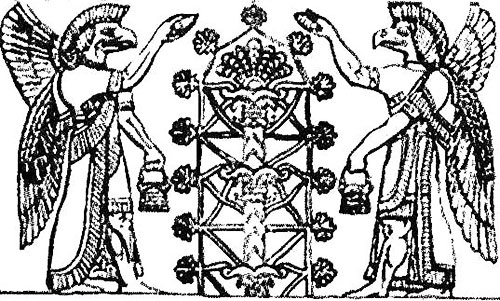
Figure 10
The Igigi (Biblical "angels")
Nammur, the Enlil, named the present Era the Age of the Bull
(Taurus),[8] and started teaching the humans to
use bricks to build cities of mud, and temples for the royal
Nibiruans and the Angels (Igigi).[9]
These Royals were given numerical ranks from which
they were worshipped by the humans. The higher the number, the
higher up in the hierarchy, and the more power they had.
So, Nammur
made sure humankind learned about hierarchy as well, something that
has halted our evolvement quite substantially over time.
This is how the hierarchy was numbered:
Anu 60
Nammur (the Enlil) 50
Ninurta (Nammur's son and successor) 50
Ea (the Enki) 40
Nannar (son of Enlil) 30
Utu/Shamash (son of Nannar) 20
Inanna (sister of Utu) 15
How they came up with this hierarchy and why it was
accepted by lower rank gods/goddesses like Inanna and Marduk, is
unclear, but I haven't seen any indications of that this rank was
protested across the lines.
8. Educating Mankind
The gods then built the cities of Edin (Mesopotamia), and in each
city they build a temple where humans could worship their gods.
Ninurta got Lagash, where he got hangars for his
aircraft, and armory for his missiles. He may as well have been one
of the gods who taught humankind about warfare, being the Enlil's
"warrior son".
Utu, who rebuilt the city of Sippar, taught law to
the humans, and Nannar was given the city of Urim. Iškur returned
from the Andes to reside in a temple in the mountains north of
Mesopotamia (Sumer). Marduk and Nabu, his son, came over to stay
with Ea in Eridu.
As we can see, the Enlil's Ram Clan was in charge of most of
Mesopotamia. Inanna chose the first king to be the Lugal. The Lugal
represented the Lords of the Adapites there (human descendents of
Ziusudra). Ram Clan appointed lugals then ruled the Land Between the
Rivers for 24,510 years.
They shifted their Admin Center from Kush to Uruk,
then to Akad; all areas ruled by the Anunnaki Council.
9. The Tower of Babel
The Igigi had great estates in Lebanon and Sumer, where they ruled
in abundance.
The estates grew as they continued mating with humans,
and the number of offspring increased.
Marduk taught these hybrids to make brick for Babylon, which was
going to be his own spaceport. By having one of his own, he could
challenged Utu with his Ram Clan spaceport in the Sinai. Nammur saw
what was happening and asked Marduk to drop the project peacefully,
but Marduk didn't listen and continued building the launch tower of
Babylon.[10]
By 3,450 BC, Nammur told his lieutenants that Marduk was building a
tower, a non-permitted Gateway to Heaven, entrusting the Earthlings!
Ninurta emphasized that this had to be stopped, so at night, they
raided the area and destroyed the tower. Marduk had to flee again,
and ended up in his father's, Ea (Ptah), region, the Nile. The Ram
Clan scattered Marduk's servants and programmed them with different
languages and scripts.[11]
Marduk, now in Egypt and calling himself Ra, didn't like that his
brother, Ningishzidda (Thoth), resided in the area, and for the next
350 years, the tension between the two increased and their armies
clashed over Egypt.
Eventually, their father, Ea/Ptah, ordered Thoth
to leave Egypt to Ra.
Marduk Ra triumphed and reunited Egypt under his
command. In reality, Ea had a bad conscience that didn't go away,
for not being able to give his son the Kingdom of Nibiru to rule,
but at least he could now give him Egypt.
Ea/Ptah also gave Marduk Ra the meš (the super
computer programs) in an effort to make Egypt prosper; he gave
Marduk Ra all his knowledge, except how to revive the dead.[11a]
10. Marduk Ra is Rewriting
History
One of the first things Marduk did was to rewrite history in his
favor.
He immediately removed the head of the Sphinx, which
previously was sculptured in the image of Ningishzidda, and replaced
it with Asar, Marduk's son; this is the head we see on today's
Sphinx.
Marduk Ra wanted to place himself in the position as
the one and only God, and therefore, he wanted to erase all the
history of all the gods previous to him. [12]
NOTE: I have reasons to believe that
not only did Marduk rewrite history, but he also used BST, Blank
Slate Technology, or something similar, to erase the memory of
humankind. Another technique, which is more drastic, but quite
effective is to disconnect our minds from
the Akashic Records.
This is not that hard to do if you are aware of that the Akashic
Records for the Earth mass consciousness, from which we pull our
collective memories of our past, are located in the astral around
our planet. One way to erase our memories is to distort the
connection between the human mind and the Akashic records.
A pole shift would most
probably do it, if done artificially and scientifically, with this
goal in mind. This would not erase the Akashic Records; only our
connection with them and thus our memories of our collective past.
If this connection is tampered with and we lose our collective
memories, it's like we wake up and have no memories of our past.
We're starting all over from Day 1.
Body/mind/spirit work as
usual and can think and act as it always has, only without its
memories.
If this was what Marduk
did, he succeeded in erasing memories of previous deities.
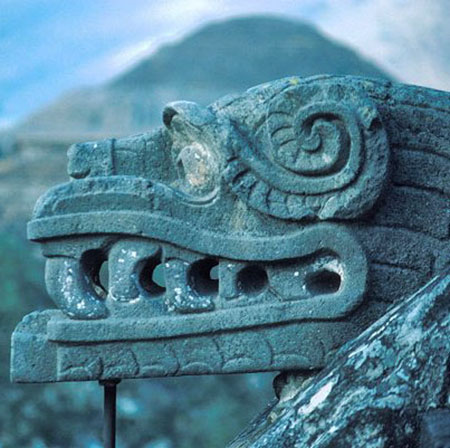 
Figure 11
Quetzalcoatl/Thoth/Ningishzidda,
here depicted in reptilian and
human form,
something that fuels the fire that
some of these beings were Reptilians.
Thoth/Ningishzidda, now exiled, moved all the way to
Mesoamerica with his loyal officers, and there became known as
Quetzalcoatl, the "Winged Serpent".[13]
11. Inanna Rules the Indus
Region and Uruk in Sumer
Nammur, who was afraid that humans would be as powerful as the gods
and learn about immortality, triggered by the Tower of Babel,
continued the ordering of writing new languages into the codes of
humans; different codes in different areas of the world to create
separation rather than unity.
So he ordered Ea to create a new language for Aratta,
Inanna's Indus Valley Civilization. However, Ea refused to give her
the meš (then in Marduk's possession) to make Aratta the World
Power.
He said Inanna could share with Aratta what she'd
already seduced out of him earlier.
Enmerkar, the second ruler in Uruk (a direct Adapan hybrid
descendant of Inanna's twin brother, Utu), sent his son, Banda, to
deliver a message saying that the Arattan King had to swear
submission to Uruk.
The Arattan king preferred a trade. He wanted the meš in exchange of
Aratta's precious stones. If Enmerkar still insisted on war, he
suggested they choose one champion from each camp to do the combat.
Banda returned to deliver to his father the reply from the Arattan
king, but he got sick on his way back and suddenly died, so the
peace message never reached Enmerkar.
Inanna, who now ruled two kingdoms, Aratta and Uruk, had still not
let her mind go off Dumuzi, and she missed him. It was so bad that
Inanna started hallucinating about him and had a harder and harder
time differentiating between the "real" world and her inner
uncontrolled emotions.
This made her pretty dangerous, due to the position
she had as Queen.
In Uruk, she set up a "House of Pleasures" (equivalent to a
"whorehouse" in today's terms).
Inanna herself took lovers from
there and elsewhere, pretending they were Dumuzi, promising them
long lives and other desirable things. Then she went to bed with
them in the evening, and when the morning broke, they were found
dead in her bed (the origins of the tale about the "Black Widow").
Utu, Inanna's twin brother, who knew the secret how to revive the
dead, managed to bring Banda back to life and brought him back to
Inanna in Uruk.
Inanna, now in a bad mental state, thought Banda was
Dumuzi, and cried out:
"This is a miracle! My beloved Dumuzi has come
back to life!"
12.
Gilgamesh and the
Elixir of Immortality
Banda then succeeded his father, Enmerkar, as the King of Uruk.
Banda married Ninurta's daughter, Ninsun, who gave birth to
Gilgamesh.
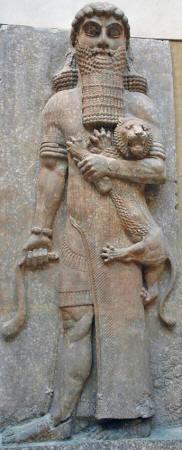
Figure 12
Gilgamesh
Gilgamesh was obsessed with immortality and would do anything to be
like the gods and live for millions of years. So he went to
Baalbek in Lebanon to plead with the
astronauts for immortality.
He and his android-guard, Enkidu, sought
the launch-pad in Lebanon, hoping the gods would give him the same
immortality they enjoyed.
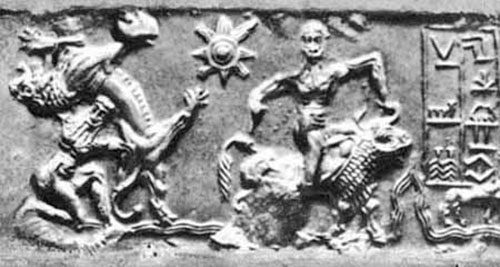
Figure 13
Gilgamesh and Enkidu
fighting the gurard-bull
From a distance, Inanna saw Gilgamesh take off his clothes to take a
bath, and she desired him.
She approached him and tried to seduce him. When
Gilgamesh refused, Inanna got furious and let loose the guard-bull
on him out on the launch-pad. However, while Enkidu held the bull,
Gilgamesh was able to stab it to death.
Still determined to find longevity, Gilgamesh continued his journey
and in a tunnel in Sinai he found Ziusudra, still alive after all
these centuries after the Deluge.
Ziusudra then decided to give Gilgamesh monatomic
gold; something he himself had used to stay alive for so long. He
said that Ea and Nammur now granted Gilgamesh this special treatment
as well.
Happy, Gilgamesh left, but later, someone stole his
stash, and Gilgamesh ended up dying like any other human hybrid.
13. Marduk Offering
Pharaohs Immortality
Marduk, after have heard about Gilgamesh's obsessive search for
immortality, started pondering this whole issue to see if he could
use it to his own benefit.
He decided he could use it to establish loyalty
amongst his rulers and high priests. Hence, he told his Egyptian
kings that they would journey in their afterlife to Nibiru and enjoy
immortality together with the gods.
This Immortality Cult could unite the kings around
the Nile and strengthen Marduk's position against Inanna.

Figure 14
Babylon
Inanna, who had great weapons at hand, armies and was in possession
of gold powder for her own "immortality", held her position and
stronghold on Sumer for 1,000 years.
During this time, homo sapiens sapiens were
encouraged to worship the Enlilites; the Ram Clan.
In Egypt, on the other hand, Marduk introduced a totally different
religion. He taught his human servants to worship only ONE God, and
that "God" was no one less than Marduk Ra himself. He told them
there were no other gods than he, himself.
When his father, Ea,
heard of this, he was baffled, because this was totally unheard of
before.
Marduk, however, was remobilizing his armies to once again challenge
Inanna and the Enlil Clan.
In both Marduk's and Inanna's minds,
there was only room for one world ruler, not two!
14. Sargon, the Akkadian
Warrior King
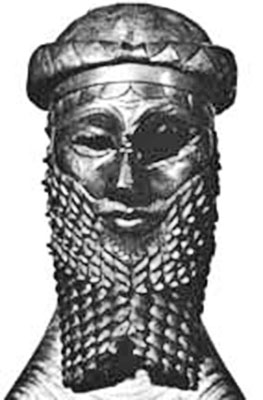
Figure 15
King Sargon
Inanna, in an effort to defeat Marduk once and for all, decided she
wanted a strong warrior king.
In 2,400 BC, she chose her gardener, Sargon, to lead
her human armies and rule Sumer for her. Why Sargon? Because he had
the stomach to rape Inanna, his own Queen, and Inanna enjoyed it.
She was fascinated by his courage to do so, and his
physical strength. She even managed to convince Nammur about her
choice of warrior king. Inanna and Sargon thus ruled from Akkad
(Agade), which they built close to Babylon.
In 2316 BC, Marduk and his son Nabu were in Egypt, and Sargon saw
the opportunity.
With his great army, he invaded Marduk's Babylon,
and then withdrew. When Marduk and his son returned from Egypt they
fortified the city to keep his enemies out. In addition, Marduk
decided to build his spaceport in Babylon, the heart of Edin.
Inanna got furious and she and Sargon started a gigantic war against
Marduk. What followed was the bloodiest war in Earth's history, and
both sides used laser weapons on each other's human soldiers.
Eventually, Sargon died in battle.[14]
15. Inanna's Armies Move
Forward
After the intense war had subsided, Nergal, Marduk's brother,
visited Inanna in Uruk and allied with her, although he was an
Enkiite.
Thus, Nergal became Inanna's lover, and together they
planned how to rule the world by first defeating Marduk.
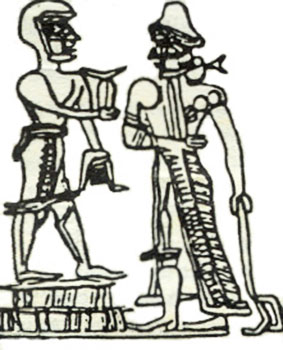
Figure 16
Marduk (left) greeting his
brother, Nergal, in Babylon
As part of the plan, Nergal left Uruk and he and his men rode to
Babylon, where Marduk greeted his brother.
Nergal said that if Marduk would leave Babylon
immediately, and go to South Africa, he could secure weapons and
computer systems that had been hidden there since the Deluge. Marduk,
who had no reason to mistrust his brother, acted on it and left.
While Marduk was in South Africa, Nergal broke into Marduk's control
room and stole his "brilliance" (energy radiation source),
controlling the irrigation system for all Mesopotamia.
Ea did not approve of this and banished Nergal back to Africa, but
Nergal still left a garrison of men near Babylon, where they could
aid Inanna.
In 2291 BC, Inanna, Naram-Sin (Sargon's grandson) and the Akkadian
armies captured the spaceport in Lebanon. From there, they conquered
Jericho, which up until then had been under Nannar's (Inanna's
father) control.
Encouraged by previous successes, Inanna moved on, joined armies
with Nergal, and conquered Egypt. In her efforts to become the Queen
of Earth, Inanna, in 2255 BC, destroyed Anu's Temple and sent Naram-Sin
to Nippur to attack Nammur's minions there.
Nammur did not let this go unhandled for long. In rage, he sent his
son Ninurta and his army to stop Inanna. He massacred all humans he
could find in Akkad and to reconquer Mesopotamia. He ordered Naram-Sin
to be killed and Inanna arrested and brought before him.
Inanna, however, got away and fled to Nergal in South
Africa, and for seven years the plotted how to overthrow the
Anunnaki Council.
16. The Enlil Visited by
Galzu in Dream State
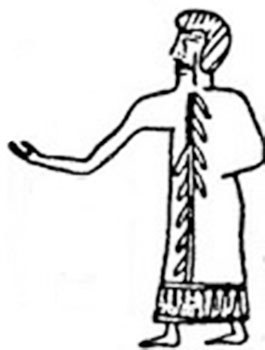
Figure 17
Galzu
Galzu, the mysterious person, whom had managed to get the great King
Anu to realize that he should leave humankind to rule the Earth,
once again showed his non-physical presence; this time to the Enlil,
in dream state.
By now, the Anunnaki considered him a representative
of the Creator, or All That Is, and had deep respect for him.
Galzu warned him that when Earth moved zodiacally from the Age of
the Bull (Taurus) to the Age of the Ram (Aries), Marduk would rule
the Earth.
He further told the Enlil:
"a righteous and worthy man must be chosen, by
him and his seed will Civilized Man be preserved!"
Nammur thought a lot about this vision, which he kept
to himself.
He decided to send Ibruum/Abraham, son of Nannar's
high priest king, Tirhu (a hybrid with a lot of Anunnaki genes in
him) on missions to thwart Marduk's moves to position his forces to
capture the spaceport on the Sinai.
As soon as Ibruum left Harran, Marduk moved in and
the next 24 years he spent planning on how to take over Earth.
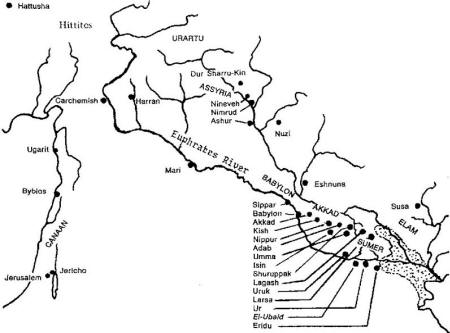
Figure 18
Map of Harran and environs
17. The Anunnaki Drop
Nuclear Bombs Over Sinai Spaceport Before Leaving Earth to Marduk
The Anunnaki and the Nibiruan Ša.A.M.i. knew that they soon would
have enough gold to shield Nibiru's atmosphere, and they could all
go back to their home planet.
Then they could leave homo sapiens sapiens to manage
on their own.
By the end of their stay on Earth, the Anunnaki tried to end all
their old feuds with each other, perhaps to not bring these
conflicts back to Nibiru. The humans were used as slave labor to dig
up the last gold resources and precious metals and stones needed,
and had them help out with other things, too.
Not the least, they had human armies fight wars and
battles between the gods to settle things between rival parties. And
rival parties there were!
On the one hand, there was Nammur and Ninurta, who used hybrid
armies (humans) and Nibiruan weapons in Sumer to fight against
Inanna when she invaded the Anunnaki reserve in the Spaceport area.
On the other hand, there was Marduk Ra, who
proclaimed his "divine right" to rule on Earth. The Nibiran Council
still refused to let Marduk come back to Nibiru, because they were
afraid he was going to plot a coup to take over the Kingdom.
And on Earth, they did not know what to do with him
either.

Figure 19
Nabu
So they gathered the Anunnaki Council to discuss the
matter.
All council members were against Marduk and Nabu, and
saw them as a major problem in all camps. Most of the Anunnaki on
Earth were eager to leave and go home, but before they did, they
decided that if Marduk would be the ruler of Earth, at least they
should deny him the Spaceport in the Sinai.
All senior Anunnaki, except Ea, agreed to use nuclear
weapons to stop Nabu's advance through Canaan towards the Sinai
Spaceport.
Before the Anunnaki Council executed their orders, they radioed King
Anu on Nibiru and asked him of permission to nuke the spaceport and
Nabu's human armies. Stunningly, Anu gave his permission! This
speaks a lot about the Ša.A.M.i. on the home planet, and not only of
the Anunnaki down here on Earth.
A lack of compassion seems to run in the blood of
these beings, at least on royal levels, which is that counts for us
humans, because they are the ones who make the decisions, the
Ša.A.M.i. people.
Airships were sent down to bring the Igigi home.
In 2064 BC, Ninurta attacked the Sinai. The first
missile hit Mt. Mashu, where the controlling equipment was housed.
Then,
a nuclear bomb was dropped above
the Place of the Celestial Rocketships, with a brilliance of seven
suns. The Earth shook and crumbled, the heavens were darkened after
the attack, and of all the beautiful forests were destroyed, leaving
only burnt stems left.[15] [16]
Nergal, Ea's son, bombed Marduk's forces in Canaan.
He nuked Sodom and Gomorrah, and three other cities
allied with Marduk. These nukes were what made the Dead Sea dead,
and it still hasn't recovered in today's 21st Century. There is
still radioactivity in the area today, enough to induce
sterility in animals and people who absorb the water there.
Archeologists confirm the flooding, abandonment of
the area and sudden deadening of life in 2024 BC. The destruction
was tremendous...
And with that, most of
the Anunnaki
left the planet, just as
destructively as the once arrived.
Notes
[1] Sitchin, Z., 2002, "The Lost Book of Enki",
p. 238.
[2] For more information about the two clans, see, Bordon, A.R.,
2007: "The
LINK - Extraterrestrials in Near Earth Space and Contact on the
Ground".
[3] Sitchin, Zecharia: "The
Stairway to Heaven" pp. 263-264.
[4] Sitchin, Zecharia: "The Lost Book of Enki", 2002.
[5] The Founders come to mind. Did a messenger from the senior
creator gods appear in the incarnation of Galzu to save the
Living Library and the human experiment? Makes me wonder. See
Metaphysics Paper #1: "The
Prime Creator Experiencing Itself" under section 2:
"A Hierarchy of Creator Gods". Another option is that Galzu
never existed, but was used as a justification for future use
when the "gods are returning", so they can say that Galzu told
them to give Earth to us, when in reality they come to invade.
Anu's contemplations in the referred paragraph to leave
earthlings alone could easily be convincing if there wasn't
additional information which contradicts Anu's decision. The
Anunnaki never had any intentions to give up their real estate
and the earthlings. I strongly believe this Sitchin part is
disinformation on the Anunnaki's part.
[6] Sitchin, Z., 1985, "The Wars of Gods and Men",
pp. 129-135; 2002, "The Lost Book of Enki",
pp. 271 - 272.
[7] Sitchin, Z., 2002, "The Lost Book of Enki", p. 275.
[8] Here is where the Pleiadians come into the picture again. In
Marciniak's channeling,
the Pleiadians tell us they are the "Bulls" and that the
Pleiades are in the constellation of Taurus. In context, it is
clear that the Pleiadians take responsibility for have been
teaching mankind the same things the Anunnaki were now teaching
us.
The Pleiadians admit to that there was a
cooperation and correlation somewhere along the lines of time
between the Anunnaki and the Pleiadians, as we also shall see
when we go into the Atlantis papers later. I am not sure when
and how this cooperation started, but there are more sources
indicating that some of the Pleiadians came back from their
refuge to the young star system and started working together
with the Anunnaki.
Sounds like this is when King Anu gave the task
to the Pleiadian allies to teach mankind certain important
things to survive. This is also the part of this whole drama
Marciniak's Pleiadians are most proud of; how they taught
mankind to take care of themselves.
However, it seems that the real reason why Anu wanted to teach
mankind was so that we could be self-sufficient and survive
while the Anunnaki were off planet, just to come back in the
21st Century AD. Anu apparently thought the Pleiadians were most
suited for this task.
[9] The Pleiadians are referring to the Igigi as being the
angels of the Bible in one of their channel sessions [Barbara
Marciniak channeling the Pleiadian, December 2010].
[10] Sitchin, Z., 1995, "Divine Encounters",
pp. 110 - 115; 2002, "The Lost Book of Enki", pp. 281 - 282.
[11] This was most certainly done by once again tamper with
their DNA. Today, scientists are beginning to understand that
language is a program within our DNA, and is not something
mankind comes up with randomly. There is an order to it. That's
why when you learn a few languages, it's getting much easier to
learn others, even if they are not of the same language category
and have little in common. Skilled linguists, who talk a lot of
different languages are aware of this.
[11a] Maybe "reviving the dead" was, like I suspect and
mentioned earlier, a technology used to transfer the soul of a
dead Anunnaki to his/her cloned body, stored somewhere else,
most probably on Nibiru.
[12] Sitchin, Z., 2002, "The Lost Book of Enki", pp. 284 -285;
Morning sky, Robert, 1996, "The Terra Papers".
[13] Sitchin, Z., 2002, "The Lost Book of Enki", pp. 284 -285.
[14] Sargon was never resurrected/revived by Inanna or any other
god. The old Sumerian tablets apparently don't tell us why some
were revived and others not. Same thing goes for Dumuzi; Inanna
spent the rest of her earthly existence mourning him, but Dumuzi
was never revived.
Why? We simply don't know; his body could have
been too demolished when they found it. However, the question
remains why they didn't resurrect certain important humans or
gods, while they did others.
[15] Sitchin, Z., 2002, "The Lost Book of Enki", p. 310.
[16] Sitchin in "The
Case of The Evil Wind", writes that, starting in
1999, scientists found evidence that the depopulation of Sumer
coincided with abrupt climate change [See Science, April 27,
2001 and Geology, April 2000].
DeMenocal, who wrote the article in Science cited
in brackets above, used as evidence for the abrupt changes in
the area's vegetation, rocks called tephera. Tephera are
"burnt-through pieces of blackened gravel-like rock" usually
associated with volcanos. Tephera still cover Sinai - which
lacks volcanoes.
Sinai's tephera result from Ninurta's bombing of
the spaceport. The bombing left a huge black scar on the Sinai
plain (where the shuttlecraft runway and launch platform had
been) so large it can only be seen from satellite.
Millions of black-blasted rocks, north northeast
of the scar in an area where all other color rocks - no black -
are found. [See photos, The Wars of Gods and Men, 1985, pages
332-334]
|



















